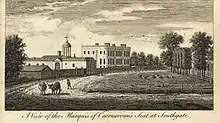David Hechstetter
Sir David Hechstetter (or Heckstetter, Hetchetter, Hochstetter, or Hockstetter; c. 1659 – 14 June 1721) was a director of the Company of Merchant Adventurers of London (the Hamburg Company) and a land-owner in Hertfordshire and Middlesex. He was a justice of the peace for Middlesex and was knighted in 1714.
David Hechstetter | |
|---|---|
| Born | c. 1659 |
| Died | 14 June 1721 (aged 61–62) |
| Nationality | British |
| Occupation | Merchant |
| Board member of | Company of Merchant Adventurers of London (the Hamburg Company) |

Early life
David Hechstetter was born around 1659.[2] His place of birth is unknown. According to John Burke, he changed his name from Hockstetter (see Höchstetter) to Hechstetter and his family were accorded great honour in Germany by Emperor Maximilian of the Holy Roman Empire.[3]
Family
Hechstetter married twice, first to a lady by the name of White, and secondly to a lady named Harrison who was originally from the Duchy of Brunswick.[4] One of his wives was treated by the naturalist and physician Martin Lister when she fell ill and Hechstetter wrote to Lister in 1699 when she recovered.[5]
His son, who succeeded him, was also named David.[6] His younger son was named Christopher and his daughters were Mary and Anne.[7] Mary's son was David Michel (c. 1735 – 1805), the member of Parliament for Lyme Regis in the 1780s.[8]
Career
David Hechstetter was a director of the Company of Merchant Adventurers of London (the Hamburg Company).[9] He was an investor in the Bank, the old East India Company, and the South Sea Company in which he had four votes.[5] In 1704, he acquired land at Dancers Hill in Hertfordshire from Thomas Andrews on which the current Dancers Hill House was built around 1750–60.[6][10]
He was a justice of the peace for Middlesex and was knighted in 1714.[9][11] He resided at Minchington Hall in Southgate, Middlesex, as lessee from 1714 and purchased land that was part of the Minchington estate from Sir Nicholas Wolstenholme in 1716.[12]
Death and legacy
Hechstetter died on 14 June 1721.[13] His 1720 will is held by the British National Archives at Kew and left his estate principally to his wife, Dame Mary Hechstetter, and their children, with legacies of £200 to Christchurch Hospital and £300 to his cousin John Lister. He directed that his body be buried in the vault of the chapel of St Arnold's without any "pompous ostentation".[7]
A marble memorial to Hechstetter stood in the nave of the Weld Chapel, Southgate.[14] It was removed to Christ Church, Southgate, when the chapel was demolished in the mid-nineteenth century.[15] It includes Hechstetter's coat of arms.[4]
References
- Goadby, Robert. (1776) A New Display of the Beauties of England &c. Vol. I. 3rd edition. London: R. Goadby. p. 156.
- Jones, Clyve, & Geoffrey Holmes. (Eds.) (1985) The London Diaries of William Nicolson, Bishop of Carlisle 1702–1718. Oxford: Oxford University Press. p. 632; ISBN 0198224044
- Burke, John (1837). A Genealogical and Heraldic History of the Landed Gentry; Or, Commoners of Great Britain and Ireland &c. Vol. II. London: Henry Colburn. p. 651.
- Edmonton. British History Online. Retrieved 25 December 2018.
- 21 March 1699: Hechstetter, David, d. 1721 (London, England) to Lister, Martin, 1639–1712 (London, England). Early Modern Letters. Retrieved 26 December 2018.
- South Mimms: Manors. British History Online. Retrieved 24 December 2018.
- Will of Sir David Hechstetter of Edmonton, Middlesex. National Archives. Retrieved 25 December 2018.
- Michel, David Robert (?1735–1805), of Dewlish, Dorset. The History of Parliament. Retrieved 29 December 2018.
- Shaw, W. A. (1970). The Knights of England: A Complete Record from the Earliest Time to the Present Day &c. Vol. 1. Clearfield. p. 279. ISBN 978-0-8063-0443-4.
- Historic England. "Dancers Hill House (1103562)". National Heritage List for England. Retrieved 24 December 2018.
- The Political State. Vol. 30. London. 1725. p. 415.
- Edmonton: Other estates. British History Online. Retrieved 26 December 2018.
- Price, Jacob M. "The Tobacco Adventure to Russia: Enterprise, Politics, and Diplomacy in the Quest for a Northern Market for English Colonial Tobacco, 1676-1722." Transactions of the American Philosophical Society, New Series, Vol. 51, No. 1 (1961), pp. 1–120. doi:10.2307/1005870
- Robinson, William. (1819). The History and Antiquities of the Parish of Edmonton &c. London: William Robinson. p. 138.
- Historic England. "Christ Church Southgate Parish Church (1294372)". National Heritage List for England. Retrieved 25 December 2018.